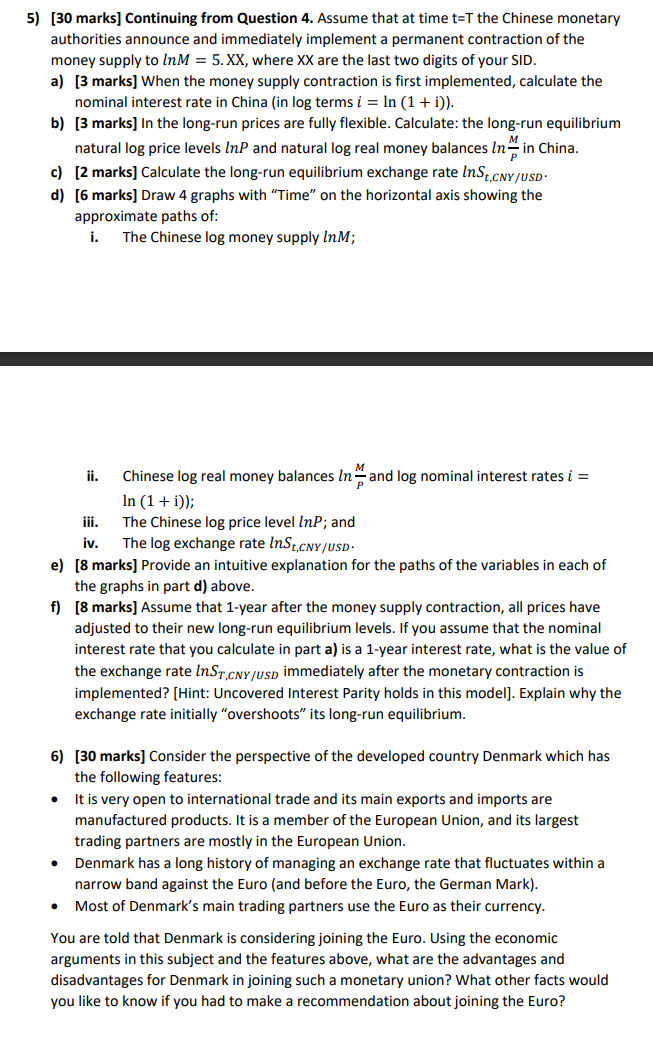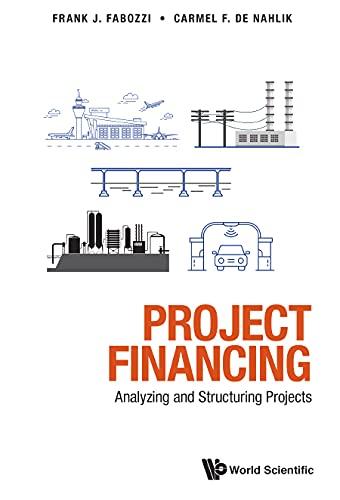
5) [30 marks] Continuing from Question 4. Assume that at time t=T the Chinese monetary authorities announce and immediately implement a permanent contraction of the money supply to InM = 5. XX, where XX are the last two digits of your SID. a) [3 marks] When the money supply contraction is first implemented, calculate the nominal interest rate in China (in log terms i = ln (1 + i)). b) [3 marks] In the long-run prices are fully flexible. Calculate: the long-run equilibrium natural log price levels InP and natural log real money balances in in China. c) (2 marks] Calculate the long-run equilibrium exchange rate in St.CNY/USD- d) [6 marks] Draw 4 graphs with "Time" on the horizontal axis showing the approximate paths of: i. The Chinese log money supply InM; M ii. Chinese log real money balances in and log nominal interest rates i = In (1 + i)); iii. The Chinese log price level InP; and iv. The log exchange rate In St.CNY/USD. e) [8 marks] Provide an intuitive explanation for the paths of the variables in each of the graphs in part d) above. f) [8 marks] Assume that 1-year after the money supply contraction, all prices have adjusted to their new long-run equilibrium levels. If you assume that the nominal interest rate that you calculate in part a) is a 1-year interest rate, what is the value of the exchange rate InST.CNY/USD immediately after the monetary contraction is implemented? (Hint: Uncovered Interest Parity holds in this model). Explain why the exchange rate initially "overshoots" its long-run equilibrium. . . 6) (30 marks] Consider the perspective of the developed country Denmark which has the following features: It is very open to international trade and its main exports and imports are manufactured products. It is a member of the European Union, and its largest trading partners are mostly in the European Union. Denmark has a long history of managing an exchange rate that fluctuates within a narrow band against the Euro (and before the Euro, the German Mark). . Most of Denmark's main trading partners use the Euro as their currency. You are told that Denmark is considering joining the Euro. Using the economic arguments in this subject and the features above, what are the advantages and disadvantages for Denmark in joining such a monetary union? What other facts would you like to know if you had to make a recommendation about joining the Euro? 5) [30 marks] Continuing from Question 4. Assume that at time t=T the Chinese monetary authorities announce and immediately implement a permanent contraction of the money supply to InM = 5. XX, where XX are the last two digits of your SID. a) [3 marks] When the money supply contraction is first implemented, calculate the nominal interest rate in China (in log terms i = ln (1 + i)). b) [3 marks] In the long-run prices are fully flexible. Calculate: the long-run equilibrium natural log price levels InP and natural log real money balances in in China. c) (2 marks] Calculate the long-run equilibrium exchange rate in St.CNY/USD- d) [6 marks] Draw 4 graphs with "Time" on the horizontal axis showing the approximate paths of: i. The Chinese log money supply InM; M ii. Chinese log real money balances in and log nominal interest rates i = In (1 + i)); iii. The Chinese log price level InP; and iv. The log exchange rate In St.CNY/USD. e) [8 marks] Provide an intuitive explanation for the paths of the variables in each of the graphs in part d) above. f) [8 marks] Assume that 1-year after the money supply contraction, all prices have adjusted to their new long-run equilibrium levels. If you assume that the nominal interest rate that you calculate in part a) is a 1-year interest rate, what is the value of the exchange rate InST.CNY/USD immediately after the monetary contraction is implemented? (Hint: Uncovered Interest Parity holds in this model). Explain why the exchange rate initially "overshoots" its long-run equilibrium. . . 6) (30 marks] Consider the perspective of the developed country Denmark which has the following features: It is very open to international trade and its main exports and imports are manufactured products. It is a member of the European Union, and its largest trading partners are mostly in the European Union. Denmark has a long history of managing an exchange rate that fluctuates within a narrow band against the Euro (and before the Euro, the German Mark). . Most of Denmark's main trading partners use the Euro as their currency. You are told that Denmark is considering joining the Euro. Using the economic arguments in this subject and the features above, what are the advantages and disadvantages for Denmark in joining such a monetary union? What other facts would you like to know if you had to make a recommendation about joining the Euro







